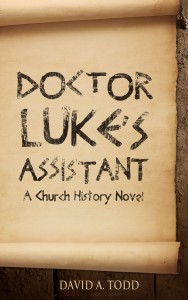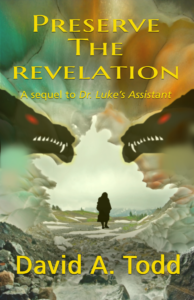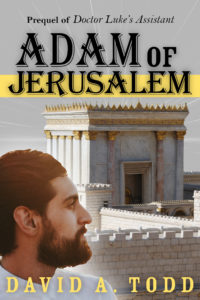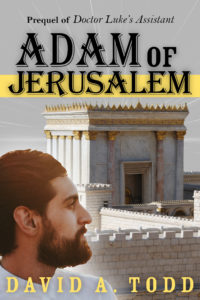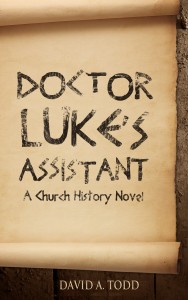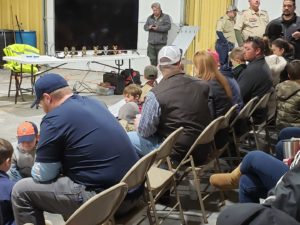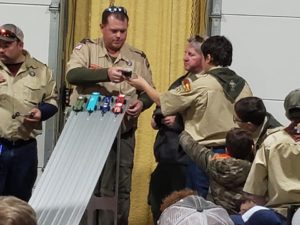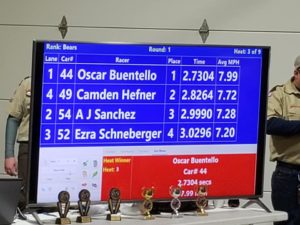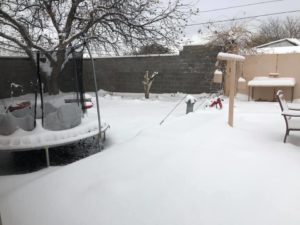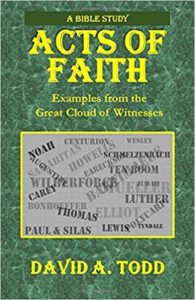
One of my March goals is to make a decision on what Bible study I will write next. Last year I published Acts Of Faith: Examples From The Great Cloud Of Witnesses. So far the feedback on it is good, even though the first print run had two embarrassing typos in the running heads and more than a few typos throughout the text. I also published a Leader’s Guide for this, which turned out to be an entirely new book.
My wife thinks I should write and publish more Bible studies. One woman in our Life Group at church wants me to submit Acts Of Faith to our denominational publishing house. Others have said I should write more like that.
In fact, I would like to write more Bible studies, and have made it a goal for 2020 to write and publish one more. Over the years, as an adult Life Group teacher, I’ve developed a number of Bible studies that I’ve then taught to our Life Group. I had my teaching notes for most of them (can’t find one, and another has rather thin notes). Any of those for which I have notes I could most likely expand into a book.
In addition, ideas for more Bible studies have come to mind. Several times over the last year I’ve listed these, even planning some of them to gauge how difficult their preparation would be. It’s one thing to say, “Hey, that would be a good Bible study,” and another to actually put it together and teach it.
Yesterday I took time to list them, the ones taught and the ones in the planning/brainstorming stage. Here they are. The ones taught are in the order I taught them in. The dates are approximate. I didn’t keep a running record of what I was teaching when, and the only way I can pin the dates down is by reviewing my teaching notes and see what dates I wrote on them (which I usually do and hope I did in the beginning).
Here are the ones taught.
- A Study in Isaiah. This was a 20-lesson series, developed and taught around 2008. So far I haven’t found my teaching notes for this.
- The Prophetic Duo: Lessons from the Lives of Elijah and Elisha. This was originally around 14 lessons, but the class wanted to look at some events in the prophets’ lives that I skipped, and it grew to 18 lessons. I believe I taught this around 2009 or 2010.
- Life on a Yo Yo: Learning from Peter’s Ups and Downs. I put this together probably in 2009 and taught it in 2010. I think it was 14-15 lessons.
- What One Thing Is Strongest? This is not, strictly speaking, a Bible study as it is from the apocryphal book of 1 Esdras. This was just a five lesson series, and the class loved it. There are some challenges in publishing it. The writing, I think, would go fairly easy.
- Malachi, the Answer Man. This study in the book of Malachi was around six or seven lessons. I didn’t seem to make a lot of notes as I taught this, though I have a couple of more places to look.
- Good King, Bad King. I did this one summer, maybe in 2013. It was to be a study of the kings of Israel and Judah. I only did two lessons, but have programmed out around 12 to 14. This one should probably be in the not-yet-developed category.
- Sacred Moments: Special Times in the Lives of Believers. This was a study of the sacraments, the seven of the liturgical churches with special emphasis on the two of the evangelical churches. I believe I taught this around 2014 in ten lessons. In addition to the sacraments, two other special times could be added to make a twelve lesson series.
- Know My Story. This was a summer fill in series of a few lessons, maybe six or seven, on lesser-known biblical people. It was well received by the class. This could be extended to almost any number of lessons. I think 14 to 18 is most likely. I’m not sure where my notes are, though I think I do. I just haven’t pulled them off the shelf since I taught it. I could almost put this in the not-yet-developed category.
- Entrusted To My Care. A study in 1 and 2 Timothy, this looked how much of Paul’s instruction to his protege pastor applies to laymen. I taught this in 2016-17, and it was taught again last fall at a Wednesday evening class, mostly by another teacher from my notes, but I took a couple of weeks of it. This is the Bible study for which I have the most notes.
- A Christmas Study. This took a look at all the biblical events of Advent and Christmas, put them in a chronological order, and studied them. I forget how many lessons this was, but I think ten or so, maybe a couple more. We did this over Christmas 2018 and into 2019. One lady in our class has encouraged me to publish this.
- Acts Of Faith. Developed, written, and published in 2019, we started
And here are the ones in the planning stage.
- From Slavery to Nationhood. A study of the people of Israel from Exodus, Leviticus, Numbers, Deuteronomy, and maybe a little into Joshua. Somewhere I have programming notes on this, which I hope I can find.
- To Exile and Back. This is to be a study of Israel from their exile to Babylon to their return. I did fairly extensive research into this a few years ago and found it harder to develop than I expected. Hence it’s on the shelf for now.
- Lazarus, Come Forth! This is a study of Jesus raising Lazarus from the dead. It includes many interesting interactions with people. I programmed this some time ago, and think it would make six lessons, maybe seven. I haven’t taken this much more than brainstorming and preliminary programming.
Alas, my post is long already. On Friday I’ll reveal which one I’m going to write next.
